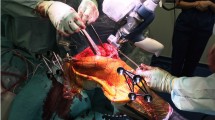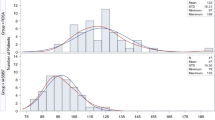Abstract
Purpose
Robotic-assisted total knee arthroplasty (RA-TKA) was introduced to improve limb alignment, component positioning, soft-tissue balance and to minimize surgical outliers. This study investigates perioperative outcomes, complications, and early patient-reported outcome measures (PROMs) of one imageless RA-TKA system compared to conventional method TKA (CM-TKA) at 24-month follow-up.
Methods
This multi-surgeon retrospective cohort analysis compared 111 imageless RA-TKA patients to 110 CM-TKA patients (n = 221). Basic demographic information, intraoperative and postoperative data, and PROMs, including the functional score of the Knee Society Score (KSS-FS), The Western Ontario and McMaster Universities Osteoarthritis Index (WOMAC), and the Short Form 12 Mental and Physical scores (SF-12M and P), were collected and recorded preoperatively, at 3-, 12- and 24-months postoperatively. Range of motion (ROM), estimated blood loss (EBL), surgical duration, and complications were also collected.
Results
There were no baseline patient demographic differences between groups. EBL (240 vs. 190 mL, p < 0.001) and surgical duration (123 vs. 107 min, p < 0.001) were significantly greater in RA-TKA. There were no significant differences in postoperative complications, ROM, length of stay (LOS), and PROMs between cohorts at 3-, 12-, 24-months postoperatively.
Conclusions
Imageless RA-TKA is associated with greater EBL and surgical duration compared to CM-TKA. However, at 24-month follow-up, there were no significant differences in ROM, LOS, complications and PROMs between cohorts. Imageless robotic surgery leads to similar 24-month clinical outcomes as compared to CM-TKA.
Level of evidence
III

Similar content being viewed by others
References
Agarwal N, To K, McDonnell S, Khan W (2020) Clinical and radiological outcomes in robotic assisted total knee arthroplasty: a systematic review and meta-analysis. J Arthroplasty. https://doi.org/10.1016/j.arth.2020.03.005
Bohl DD, Ondeck NT, Darrith B, Hannon CP, Fillingham YA, Della Valle CJ (2018) Impact of operative time on adverse events following primary total joint arthroplasty. J Arthroplasty 33:2256–2262
Bollars P, Boeckxstaens A, Mievis J, Kalaai S, Schotanus M, Janssen D (2020) Preliminary experience with an image-free handheld robot for total knee arthroplasty: 77 cases compared with a matched control group. Eur J Orthopaedic Surg Traumatol 30:723–729
Brown MJ, Matthews JR, Bayers-Thering MT, Phillips MJ, Krackow KA (2017) Low incidence of postoperative complications with navigated total knee arthroplasty. J Arthroplasty 32:2120–2126
Cho K-J, Seon J-K, Jang W-Y, Park C-G, Song E-K (2019) Robotic versus conventional primary total knee arthroplasty: clinical and radiological long-term results with a minimum follow-up of ten years. Int Orthop 43:1345–1354
Elbuluk AM, Vigdorchik JM (2019) Total knee arthroplasty technique: NAVIO. Robotics in knee and hip arthroplasty. Springer, Berlin, pp 145–156
Jeon S-W, Kim K-I, Song SJ (2019) Robot-assisted total knee arthroplasty does not improve long-term clinical and radiologic outcomes. J Arthroplasty 34:1656–1661
Kamara E, Berliner ZP, Hepinstall MS, Cooper HJ (2017) Pin site complications associated with computer-assisted navigation in hip and knee arthroplasty. J Arthroplasty 32:2842–2846
Kaper B (2020) Early results of patient-reported outcome measures in robotic-assisted total knee arthroplasty Paper presented at: Orthopaedic Proceedings
Kaper B (2020) Measurment of full arc range of motion soft-tissue balance in robotic-assisted total knee arthroplasty Paper presented at: Orthopaedic Proceedings
Kim Y-H, Park J-W, Kim J-S (2018) 2017 Chitranjan S. Ranawat Award: does computer navigation in knee arthroplasty improve functional outcomes in young patients? A randomized study. Clin Orthop Relat Res 476:6
Kim Y-H, Park J-W, Kim J-S (2012) Computer-navigated versus conventional total knee arthroplasty: a prospective randomized trial. J Bone Joint Surg Am 94:2017–2024
Kim Y-H, Yoon S-H, Park J-W (2020) Does robotic-assisted TKA result in better outcome scores or long-term survivorship than conventional TKA? a randomized, controlled trial. Clin Orthop Relat Res 478:266–275
Liow MHL, Xia Z, Wong MK, Tay KJ, Yeo SJ, Chin PL (2014) Robot-assisted total knee arthroplasty accurately restores the joint line and mechanical axis. A prospective randomised study. J Arthroplasty 29:2373–2377
Lombardi A Jr, Berend K, Adams J (2014) Why knee replacements fail in 2013: patient, surgeon, or implant? Bone Joint J 96:101–104
Mathis DT, Hirschmann MT (2021) Why do knees after total knee arthroplasty fail in different parts of the world? J Orthop 23:52–59
Mathis DT, Lohrer L, Amsler F, Hirschmann MT (2021) Reasons for failure in primary total knee arthroplasty—an analysis of prospectively collected registry data. J Orthop 23:60–66
Moschetti WE, Konopka JF, Rubash HE, Genuario JW (2016) Can robot-assisted unicompartmental knee arthroplasty be cost-effective? A Markov decision analysis. J Arthroplasty 31:759–765
Shah RP, Lauthen D, Geller JA, Cooper HJ (2019) Average operative times for 1,313 primary total hip arthroplasty and 1,300 primary total knee arthroplasty over 39 months are roughly equal to medicare attributed operative times. J Arthroplasty 34:1553–1556
Song E-K, Seon J-K, Park S-J, Jung WB, Park H-W, Lee GW (2011) Simultaneous bilateral total knee arthroplasty with robotic and conventional techniques: a prospective, randomized study. Knee Surg Sports Traumatol Arthrosc 19:1069–1076
Song E-K, Seon J-K, Yim J-H, Netravali NA, Bargar WL (2013) Robotic-assisted TKA reduces postoperative alignment outliers and improves gap balance compared to conventional TKA. Clin Orthop Relat Res 471:118–126
Vaidya NV, Deshpande AN, Panjwani T, Patil R, Jaysingani T, Patil P (2020) Robotic-assisted TKA leads to a better prosthesis alignment and a better joint line restoration as compared to conventional TKA: a prospective randomized controlled trial. Knee Surg Sports Traumatol Arthrosc. https://doi.org/10.1007/s00167-020-06353-2
Funding
None.
Author information
Authors and Affiliations
Corresponding author
Ethics declarations
Conflict of interest
JAG has received speaker honorarium and consultancy fees from Smith and Nephew, Inc.
Ethical Approval
All procedures performed in studies involving human participants were in accordance with the ethical standards of the institutional and/or national research committee and with the 1964 Helsinki declaration and ins later amendments or comparable ethical standards.
Informed consent
For this type of study formal consent is not required.
Additional information
Publisher's Note
Springer Nature remains neutral with regard to jurisdictional claims in published maps and institutional affiliations.
Rights and permissions
About this article
Cite this article
Held, M.B., Gazgalis, A., Neuwirth, A.L. et al. Imageless robotic-assisted total knee arthroplasty leads to similar 24-month WOMAC scores as compared to conventional total knee arthroplasty: a retrospective cohort study. Knee Surg Sports Traumatol Arthrosc 30, 2631–2638 (2022). https://doi.org/10.1007/s00167-021-06599-4
Received:
Accepted:
Published:
Issue Date:
DOI: https://doi.org/10.1007/s00167-021-06599-4




